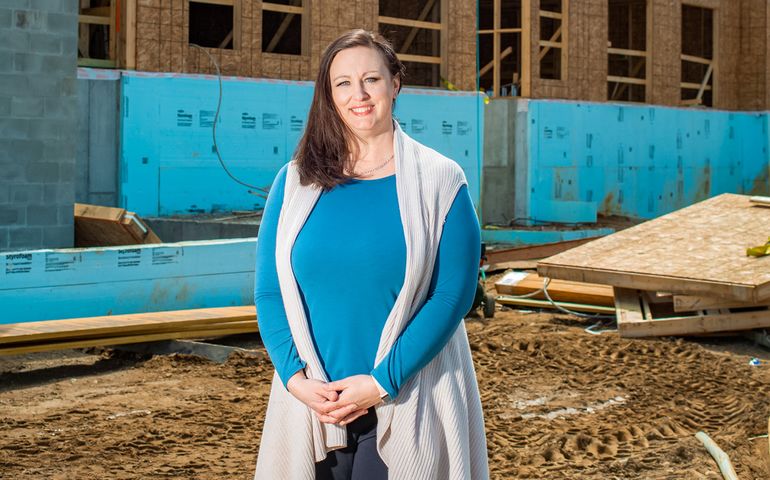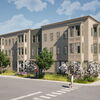
Processing Your Payment
Please do not leave this page until complete. This can take a few moments.
- News
-
Editions
View Digital Editions
Biweekly Issues
- December 1, 2025
- Nov. 17, 2025
- November 03, 2025
- October 20, 2025
- October 6, 2025
- September 22, 2025
- + More
Special Editions
- Lists
- Viewpoints
-
Our Events
Event Info
Award Honorees
- Calendar
- Biz Marketplace
The Maine Housing Crunch: Demand for affordable housing continues to grow
 Photo / Tim Greenway
Amy Cullen, vice president and project partner of Szanton Co., near the construction site of Milliken Heights in Old Orchard Beach. She says the need for affordable housing existed before the pandemic, but is now finally getting attention.
Photo / Tim Greenway
Amy Cullen, vice president and project partner of Szanton Co., near the construction site of Milliken Heights in Old Orchard Beach. She says the need for affordable housing existed before the pandemic, but is now finally getting attention.
The need for affordable housing has never been greater in the state, with increased applications for limited spots.
Now for the first time there could be the political and federal pandemic funding to help make small gains, advocates say.
“All of us in affordable housing have been jumping up and down and screaming and waving our hands saying there’s a problem for years. It’s like watching a car crash happening,” says Amy Cullen, vice president and project partner for the Szanton Co. “It feels like people are starting to hear us. The pandemic really brought it into focus. Lawmakers are finally paying attention.”
An amended version of the state’s affordable housing bill, LD 2003, passed, requiring towns to allow accessory dwelling units and duplexes wherever single-family homes are allowed. The bill also offers municipalities the grants and technical assistance needed to review their land-use rules, which smaller towns have said they couldn’t afford on their own.
“The issue of affordable housing and its importance has never been so in the forefront of everyone’s minds,” says Daniel Brennan, director of MaineHousing.
Still, despite these advancements, the issue of affordable housing is dire, advocates say.
“We need housing for those aging in place, housing for the homeless, refugee housing — we need it all,” Cullen said.
Maine has several unique challenges given its rural areas and old housing stock. Add to that the pandemic, rising labor and construction costs, as well as limited housing availability, and the situation gets worse. Throw in some “not in my backyard” affordable housing opponents, and the potential looming threat of a recession, and you have a recipe for disaster.
While a recession and a rise in interest rates could ease the pressure on the current housing bubble, these economic issues could make the financially vulnerable population more at risk for housing insecurity.
“Despite producing more housing than ever, more people are more vulnerable than ever and we need more options. The gap is getting wider. There are more people who need it and we can’t build it fast enough,” says Rebecca Hatfield, senior vice president of real estate at Avesta Housing.

“COVID led to a decline in people’s ability to afford housing. Any downturns in the economy would hurt. People at the lowest income levels are already unstable.”
In 2021, MaineHousing financed more than 520 units of new housing, marking the highest level ever, Brennan says. Its current pipeline of projects being underwritten or under construction includes 52 projects and more than 2,100 units.
“It’s the single largest pipeline in my history at MaineHousing and it’s still not enough to solve the problem,” Brennan says.
“The fundamental change in investment into affordable housing needs to stay at these levels for 10 more years, at least. When developers have confidence that the dollars are going to be there, they will follow through. My fear is that resources dry up.
“Affordable housing needs to be looked at not just as a government sector issue. Every municipality and person needs to get involved. It’s fundamental. Everyone needs a home that they can call their own.”
The backlog for affordable housing
At Avesta Housing, a nonprofit that develops affordable housing, applications in 2021 increased dramatically, but the number of units being produced could not keep up with demand.
Applications for affordable housing with Avesta Housing in 2021 revealed the following data:
- Total applications for affordable housing increased by 32% (6,231 in 2021 vs. 4,715 in 2020).
- More than a third of all applicants (34%) identified as being homeless.
- While Avesta added 179 new homes to its property portfolio, it was able to house just 7.8% of all applicants, a decrease from 9.2% in 2020.
Source: Avesta Housing
Mainebiz web partners

The Giving Guide
The Giving Guide helps nonprofits have the opportunity to showcase and differentiate their organizations so that businesses better understand how they can contribute to a nonprofit’s mission and work.
Learn More
Work for ME
Work for ME is a workforce development tool to help Maine’s employers target Maine’s emerging workforce. Work for ME highlights each industry, its impact on Maine’s economy, the jobs available to entry-level workers, the training and education needed to get a career started.
Learn More
Groundbreaking Maine
Whether you’re a developer, financer, architect, or industry enthusiast, Groundbreaking Maine is crafted to be your go-to source for valuable insights in Maine’s real estate and construction community.
Learn more-
The Giving Guide
The Giving Guide helps nonprofits have the opportunity to showcase and differentiate their organizations so that businesses better understand how they can contribute to a nonprofit’s mission and work.
-
Work for ME
Work for ME is a workforce development tool to help Maine’s employers target Maine’s emerging workforce. Work for ME highlights each industry, its impact on Maine’s economy, the jobs available to entry-level workers, the training and education needed to get a career started.
-
Groundbreaking Maine
Whether you’re a developer, financer, architect, or industry enthusiast, Groundbreaking Maine is crafted to be your go-to source for valuable insights in Maine’s real estate and construction community.
ABOUT
NEW ENGLAND BUSINESS MEDIA SITES
No articles left
Get access now
In order to use this feature, we need some information from you. You can also login or register for a free account.
By clicking submit you are agreeing to our cookie usage and Privacy Policy
Already have an account? Login
Already have an account? Login
Want to create an account? Register
Get access now
In order to use this feature, we need some information from you. You can also login or register for a free account.
By clicking submit you are agreeing to our cookie usage and Privacy Policy
Already have an account? Login
Already have an account? Login
Want to create an account? Register







0 Comments